The Vegan Cheese Sauce Market is estimated to be valued at USD 116.4 million in 2025 and is projected to reach USD 237.7 million by 2035, registering a compound annual growth rate (CAGR) of 7.4% over the forecast period.
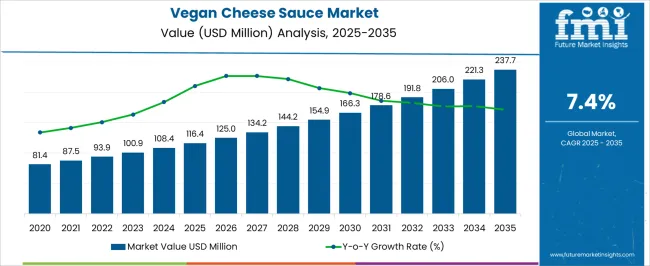
| Metric | Value |
|---|---|
| Vegan Cheese Sauce Market Estimated Value in (2025 E) | USD 116.4 million |
| Vegan Cheese Sauce Market Forecast Value in (2035 F) | USD 237.7 million |
| Forecast CAGR (2025 to 2035) | 7.4% |
The vegan cheese sauce market is undergoing notable expansion as plant-based dietary preferences, sustainability concerns, and innovations in food technology converge to reshape consumer demand and product offerings. The shift away from dairy-based sauces has been fueled by rising health consciousness, ethical considerations, and regulatory encouragement of plant-based alternatives.
Developments in formulation techniques have improved taste, texture, and nutritional profiles, enhancing the appeal of vegan cheese sauces across both retail and food service channels. Future growth is expected to be supported by increasing investments in alternative proteins, expanding distribution networks, and collaborations between manufacturers and culinary professionals to develop versatile applications.
Evolving consumer expectations for clean label, allergen friendly, and environmentally responsible products are paving the way for broader adoption and market maturity.
The market is segmented by Source and Sales Channel and region. By Source, the market is divided into Soy Milk, Oat Milk, Rice Milk, Corn Milk, Pea Milk, Almond Milk, Coconut Milk, Cashew Milk, Flax Milk, Hemp Milk, and Others (Nuts, Cassava, etc.). In terms of Sales Channel, the market is classified into B2B/ Food Service and B2C. Regionally, the market is classified into North America, Latin America, Western Europe, Eastern Europe, Balkan & Baltic Countries, Russia & Belarus, Central Asia, East Asia, South Asia & Pacific, and the Middle East & Africa.
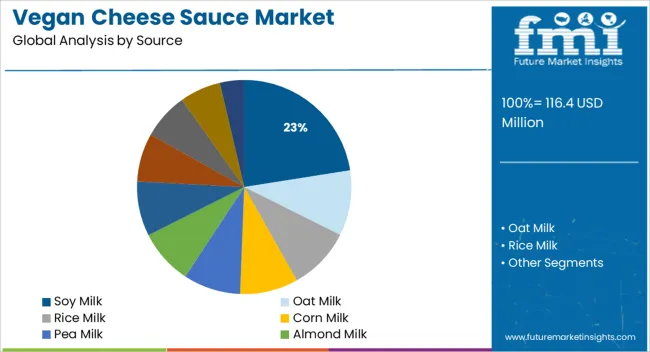
When segmented by source, the soy milk subsegment is projected to account for 22.5% of the vegan cheese sauce market revenue in 2025, making it a prominent contributor. This share has been underpinned by the well established acceptance of soy as a plant-based protein source, its neutral flavor profile, and its functional compatibility with emulsification and creamy textures required in sauces.
The presence of naturally occurring proteins in soy has been leveraged to achieve desirable mouthfeel and stability, which has resonated with both manufacturers and consumers. Advances in processing have further reduced undesirable aftertastes, enhancing consumer acceptance.
The cost efficiency of soy relative to emerging alternatives has also supported its continued dominance. Additionally, its wide availability and strong supply chain have reinforced its role as a preferred base ingredient in the vegan cheese sauce category.
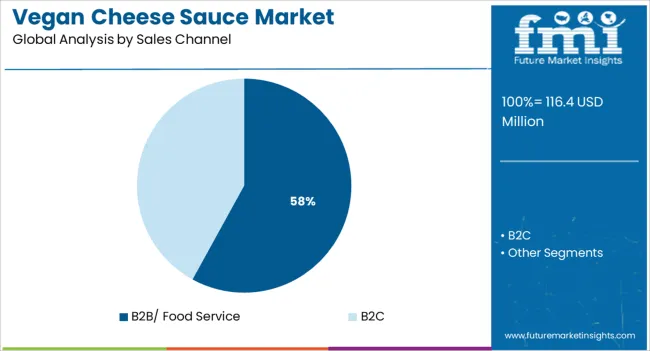
Segmented by sales channel, the B2B food service segment is expected to capture 58.0% of the vegan cheese sauce market revenue in 2025, establishing itself as the leading channel. This position has been reinforced by the growing demand for plant-based menu options within restaurants, catering, and institutional dining.
Food service operators have been increasingly incorporating vegan cheese sauces to cater to the rising number of flexitarian and vegan customers while differentiating their offerings. The scalability of B2B supply agreements, combined with the operational efficiency of bulk packaging and customization opportunities, has accelerated adoption in this segment.
Consumer preference for dining experiences that align with their dietary and ethical values has encouraged food service providers to integrate these products into their menus extensively. The ability to influence large volumes and reach a broader audience through centralized procurement has solidified the B2B food service segment’s leadership in driving growth and visibility in the market.
The global demand for vegan cheese sauce grew at a CAGR of 7.3% between 2020 and 2025, and it's expected to expand at a CAGR of 7.4% between 2025 and 2035. The growth potential of the market could be looked at from short-term, mid-term, and long-term perspectives.
| Short-Term Outlook (2025 to 2025): | Increasing global demand for vegan cheese sauce is being fueled by shifting consumer eating tastes and new developments in the food and beverage industry. Consumer tastes have shifted as the number of people with lactose intolerance and other food allergies continues to rise among both young and old. The Food Intolerance Network reports that, as of early 2024, around 70% of the global population experienced lactose intolerance. This is expected to drive the demand in the short term. |
|---|---|
| Mid-Term Outlook (2025 to 2035): | Industry growth in the Hotel/Restaurant/Café (HoReCa) sector is predicted to be bolstered by the millennial generation's trendiness toward veganism and vegetarian diets. In Saudi Arabia, for instance, vegan eateries have sprung up all over the place as a means of encouraging people to adopt more plant-based diets. Additionally, customers have been influenced to choose plant-based products due to the increased awareness of animal cruelty and worldwide worries over carbon footprint due to the animal-based diet. In addition to meat, the vegan population abstains from any items made from or including animals, including dairy (cheese, milk, cream, yogurt), eggs, and even honey, which is expected to boost the demand for vegan cheese sauce mid-term. |
| Long-Term Outlook (2035 to 2035): | Long-term trends point to growth in demand due to an expanding vegan population and rising concerns for animals' welfare. The market's profit potential is expected to expand as a result of manufacturers' heightened attention to unique product offers and increased restrictions on animal-based food items. |
The global vegan cheese sauce market is projected to be led by the proliferation of fast-food burger and pizza franchises.
A rise in global demand for cheese sauce can be attributed to the proliferation of pizza and burger fast-food restaurants as well as the growth of the pastry and bakery industry. In response to these demands, a number of well-established companies from around the world have entered the market, increasing competition significantly. The expansion of the market is forecasted to be driven by factors such as product innovation, customer retention, and price competition. In addition, developments in cheese sauces' nutritional value are likely to drive demand for cheese sauce among health-conscious customers, which is expected to further fuel the market.
The rising demand for vegan food products can be attributed to their greater availability at mass market retailers.
Products suitable for vegan diets can be found in many different types of businesses, from standard supermarkets to health food stores to internet markets to corner markets. The majority of these products are sold through grocery stores. In addition, a lot of the major supermarkets have recently started stocking vegan food options. Many grocery stores feature large window displays announcing the advent of novel plant-based product varieties. The fact that plant-based products have their own department in the supermarket probably helps to explain why they are so popular among shoppers.
Forecasted challenges for the worldwide cheese sauce industry include higher prices and potential health consequences.
However, the inevitable increase of veganism around the world is expected to be one of the primary causes holding back the sales of vegan cheese sauce. Higher prices and serious health concerns including obesity, cardiovascular disease (CVD), and diabetes are some factors that hinder the expansion of the worldwide cheese sauce industry.
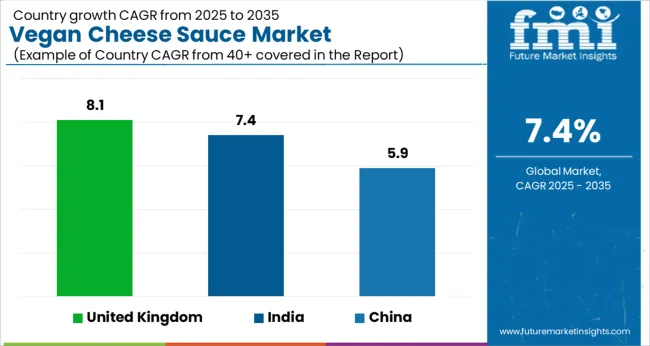
Owing to the growing number of health-conscious consumers in North America who want to boost their immune systems, the vegan cheese sauce business has seen a surge in activity. In an effort to lessen their risk of developing allergies or eczema, consumers are increasingly turning to plant-based alternatives.
Vegan cheese sauce may not be widely used during the coronavirus pandemic due to a combination of factors, including a lack of information about its benefits and high prices. Therefore, brands in the North American vegan cheese sauce industry are focusing their marketing efforts on niche consumers through stores and online. The market is expected to continue to see growth as more people learn about the immune-boosting effects of plant-based cheese.
Companies that have traditionally made cheese from milk are increasingly interested in diversifying their product line by introducing cheese made from other sources. The rising demand for plant-based products has prompted companies across the board to invest heavily in the purchase and development of new products and brands.
A total of six new vegan cheese sauces in six flavours and two styles were introduced by French dairy producer Bel Brands in April 2024. Cheese shreds, slices, and spreads are now available under Danone's plant-based dairy-free brand, So Delicious.
| CAGR (2025 to 2035) | 8.1% |
|---|---|
| UK Vegan Cheese Sauce Market Share | 9.4% |
| UK Vegan Cheese Sauce Market Valuation (2025) | USD 8.8 Million |
| UK Vegan Cheese Sauce Market Valuation (2035) | USD 20.8 Million |
One of the major factors in bad health in the United Kingdom is obesity, says Public Health England. The demand for food products with healthy ingredients is rising as people become more aware of the importance of taking care of their health. The alternative plant-based movement has gained substantial traction in the UK. In addition, these factors, as well as allergen-free varieties of traditional products (gluten-free & lactose-free) that have been extensively acknowledged by the growing number of single-person homes, have permeated the market.
In January 2025, vegan cheese sauce debuted under Aldi UK's Plant Menu label. This product is made from coconut oil and does not include any gluten or soy.
Two vegan pizzas, prepared with hand-stretched vegan dough and a plant-based cheese that does not include any dairy or animal-derived components, were reportedly introduced by Dominoes in September 2024. Also, the classic garlic and herb dip is now available in a vegan-friendly form.
Norseland Ltd., known for its Applewood brand of dairy products, reportedly plans to release a spicy plant-based version of its famous cheese flavour in July 2024, expanding its dairy-free range. The new vegan version shares the same lack of soy, nuts, milk, lactose, gluten, and eggs as the old one.
| CAGR (2025 to 2035) | 5.9% |
|---|---|
| China Vegan Cheese Sauce Market Share | 9.5% |
| China Vegan Cheese Sauce Market Valuation (2025) | USD 8.94 Million |
| China Vegan Cheese Sauce Market Valuation (2035) | USD 16.8 Million |
Chinese companies are investing heavily in product development and acquisitions to expand their product lines and meet the growing demand of Chinese consumers. Moreover, in response to the growing demand, a select number of major retailers have added more shelf space to their stores' plant-based product sections.
Funacho, a manufacturer and distributor of food dispensing equipment and items such as cheese, chilli, and condiments, has released a new, patented chilli/cheese sauce dispenser. The manufacturer claims that the dual-head, gravity-fed dispenser, which uses bottle-type cartridges to hold the substance, results in higher extraction rates than bag-type dispensers. FUNacho cartridges only contain shelf-stable, microbially safe food ingredients. The dispenser has a footprint of 10 inches wide and can store 300 ounces of product.
| CAGR (2025 to 2035) | 7.4% |
|---|---|
| India Vegan Cheese Sauce Market Share | 3.2% |
| India Vegan Cheese Sauce Market Valuation (2025) | USD 3 Million |
| India Vegan Cheese Sauce Market Valuation (2035) | USD 6.6 Million |
India ranks among the world's top consumers of vegan cheese sauce. The demand for vegan cheese sauce in India is anticipated to increase thanks to several causes, including a shift in consumption patterns, an increase in the desire for plant-based dairy products, an increase in disposable income, and a rise in the adoption of western lifestyles generally.
In addition, the hospitality and restaurant sectors have been major drivers of the vegan cheese sauce business expansion through the labelling and appetiser use of vegan cheese sauce in their establishments. Plant-based cheese is becoming more popular among lactose-intolerant and dairy-sensitive individuals.
Goodmylk, an Indian dairy company, announced in March 2025 that it has acquired the PRO2FIT nutrition brand. The acquisition of PRO2FIT shows that the Indian vegan cheese sauce market is maturing. The goals of both companies to increase people's access to healthy plant-based options led them to collaborate.
Upfield Group, a company that makes vegan butter and spreads, said in January 2024 that it had acquired Arivia, a company that makes vegan cheese sauce. Strategically, Upfield Group of Companies has acquired Arivia and its VIOLIFE brand, adding it to its roster of well-known brands including Flora, Rama, Country Crock, Blue Band, and Proactiv.
It is anticipated that the cashew category, which accounted for over 35.0% of total sales, will continue to dominate throughout the projection period. Vegetarian cheese made from cashews is a good source of protein and is fat-free, plus it's rich in vitamins B2 and B12. Due to this, it is well-liked among health-conscious shoppers all around the globe. Cashew products that don't contain gluten or cholesterol are very popular because of their positive health effects.
From 2025 to 2035, the soy industry is expected to post the highest CAGR, at 28.2%. Soy milk is a cheap alternative to dairy that contains an ideal ratio of fatty acids to amino acids. This makes it a practical option for commercial vegan cheese sauce manufacturers. Cheese made from soy is becoming increasingly popular since it melts like regular cheese.
| Segment | Distribution Channel |
|---|---|
| Top Sub-segment | Mom and Pop Stores |
| Market Share | 10.3% |
| Segment | Source Type |
|---|---|
| Top Sub-segment | Soy Milk |
| Market Share | 28.2% |
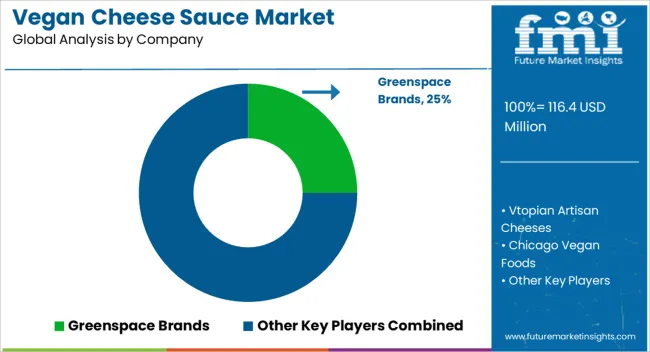
There are a lot of national and multinational firms competing in the worldwide market. As the demand for vegan goods rises, major manufacturers have been releasing new products. Examples include Aldi UK's introduction of vegan cheese in January 2025, under the Plant Menu label. It's free of gluten and soy and produced with coconut oil.
Upfield introduced their vegan cheese, Violife, to the Middle East in July 2024. The line would have two tastes, such as cheddar, and mozzarella, and be available in a variety of formats, including slices, boxes, and grated. Treeline Cheese introduced its line of vegan cream cheese in March 2024. The cheese is produced from cultivated cashew nuts and other plant-based ingredients. Three tastes are offered: basic, chive and onion, and strawberry.
The global vegan cheese sauce market is estimated to be valued at USD 116.4 million in 2025.
The market size for the vegan cheese sauce market is projected to reach USD 237.7 million by 2035.
The vegan cheese sauce market is expected to grow at a 7.4% CAGR between 2025 and 2035.
The key product types in vegan cheese sauce market are soy milk, oat milk, rice milk, corn milk, pea milk, almond milk, coconut milk, cashew milk, flax milk, hemp milk and others (nuts, cassava, etc.).
In terms of sales channel, b2b/ food service segment to command 58.0% share in the vegan cheese sauce market in 2025.






Our Research Products

The "Full Research Suite" delivers actionable market intel, deep dives on markets or technologies, so clients act faster, cut risk, and unlock growth.

The Leaderboard benchmarks and ranks top vendors, classifying them as Established Leaders, Leading Challengers, or Disruptors & Challengers.

Locates where complements amplify value and substitutes erode it, forecasting net impact by horizon

We deliver granular, decision-grade intel: market sizing, 5-year forecasts, pricing, adoption, usage, revenue, and operational KPIs—plus competitor tracking, regulation, and value chains—across 60 countries broadly.

Spot the shifts before they hit your P&L. We track inflection points, adoption curves, pricing moves, and ecosystem plays to show where demand is heading, why it is changing, and what to do next across high-growth markets and disruptive tech

Real-time reads of user behavior. We track shifting priorities, perceptions of today’s and next-gen services, and provider experience, then pace how fast tech moves from trial to adoption, blending buyer, consumer, and channel inputs with social signals (#WhySwitch, #UX).

Partner with our analyst team to build a custom report designed around your business priorities. From analysing market trends to assessing competitors or crafting bespoke datasets, we tailor insights to your needs.
Supplier Intelligence
Discovery & Profiling
Capacity & Footprint
Performance & Risk
Compliance & Governance
Commercial Readiness
Who Supplies Whom
Scorecards & Shortlists
Playbooks & Docs
Category Intelligence
Definition & Scope
Demand & Use Cases
Cost Drivers
Market Structure
Supply Chain Map
Trade & Policy
Operating Norms
Deliverables
Buyer Intelligence
Account Basics
Spend & Scope
Procurement Model
Vendor Requirements
Terms & Policies
Entry Strategy
Pain Points & Triggers
Outputs
Pricing Analysis
Benchmarks
Trends
Should-Cost
Indexation
Landed Cost
Commercial Terms
Deliverables
Brand Analysis
Positioning & Value Prop
Share & Presence
Customer Evidence
Go-to-Market
Digital & Reputation
Compliance & Trust
KPIs & Gaps
Outputs
Full Research Suite comprises of:
Market outlook & trends analysis
Interviews & case studies
Strategic recommendations
Vendor profiles & capabilities analysis
5-year forecasts
8 regions and 60+ country-level data splits
Market segment data splits
12 months of continuous data updates
DELIVERED AS:
PDF EXCEL ONLINE
Vegan Vitamin D3 Supplements Market Size and Share Forecast Outlook 2025 to 2035
Vegan Confectionery Market Size and Share Forecast Outlook 2025 to 2035
Vegan Steak Market Size and Share Forecast Outlook 2025 to 2035
Vegan Pasta Market Size and Share Forecast Outlook 2025 to 2035
Vegan Hyaluronic Acid Market Size and Share Forecast Outlook 2025 to 2035
Vegan Collagen Peptides Market Size and Share Forecast Outlook 2025 to 2035
Vegan Collagen Skincare Market Size and Share Forecast Outlook 2025 to 2035
Vegan Protein Powder Market Analysis - Size, Share, and Forecast 2025 to 2035
Vegan Tortillas Market Size and Share Forecast Outlook 2025 to 2035
Vegan Casing Market Size and Share Forecast Outlook 2025 to 2035
Vegan Dressing Market Size and Share Forecast Outlook 2025 to 2035
Vegan Dips Market Size and Share Forecast Outlook 2025 to 2035
Vegan Yogurt Market Size, Growth, and Forecast for 2025 to 2035
Vegan Meals Market Size, Growth, and Forecast for 2025 to 2035
Vegan Dog Food Market Analysis - Size, Share, and Forecast Outlook 2025 to 2035
Vegan Chocolate Market Analysis - Size, Share, and Forecast Outlook 2025 to 2035
Vegan Protein Bars Market Analysis – Size, Share & Trends 2025–2035
Vegan Vitamins and Supplements Market – Growth & Demand 2025 to 2035
Analysis and Growth Projections for Vegan Fast-Food Market
Vegan Flavor Market – Trends & Forecast 2025 to 2035

Thank you!
You will receive an email from our Business Development Manager. Please be sure to check your SPAM/JUNK folder too.
Chat With
MaRIA